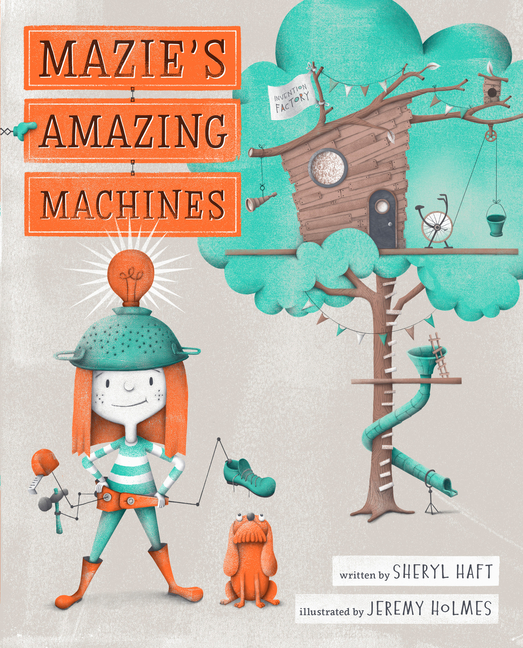From Teaching to Writing

TeachingBooks asks each author or illustrator to reflect on their journey from teaching to writing. Enjoy the following from Sheryl Haft.
HOORAY, I HAVE A PROBLEM!:
How STEAM Activities Empower Kids to Meet Problems with Positivity
by Sheryl Haft
“I need to take these papers home,” I say in my Let’s Engineer workshop for ages 4-8. I hold a stack of loose papers and stride around the classroom, swinging my arms. Of course, papers spray everywhere. Kids giggle.
“I have a PROBLEM!” I say. “How can I hold these papers together?”

“I know!” says one girl. “A stapler.”
I grab a stapler. “Someone invented this little machine,” I point out, fastening the papers with a click. “Problem solved!”
“WOW,” the kids say as if seeing the magic of a stapler for the first time.
Kids now understand that an invention solves a problem.
Reading my new picture book MAZIE’S AMAZING MACHINES together, we discover more problems…

“It’s hard for Mom to carry a stack of heavy boxes,” says the superhero inventor and kid engineer, Mazie McGear. “That’s a problem!”
“Engineering to the rescue!”
THINK BLINK! Mazie turns on her imagination.
RIBBLE SCRIBBLE! She draws.
BING BANG BOOM! She builds!
“Wheels and ramps help move things,” Mazie explains to Mom. Her Roly-Ramp invention whooshes Mom’s heavy boxes right down the stairs. PUSH WHOOSH!

We find more problems around Mazie’s house.
Mazie’s big brother Jake can’t wake up in the morning. SNOOOORE!
“I’m going to invent a special alarm clock, just for Jake.” Mazie cheers. “The Waker-Upper Rocket Machine!”

By the climax of the book, the kids are riveted by Mazie’s biggest problem of all. How will Mazie get her dog, Doodle, down from the top of the roof!? “Yip!” Doodle cries.

Finishing the story with Mazie’s family “Hug-A-Love Machine”, we then explore the glossary of Mazie’s 6 Simple Machines: The Pulley, Lever, Inclined Plane, Screw, Wheels and Axels and Wedge. Now students are ready to take on a problem of their own.
I point to a bowl on the floor: “Doodle’s bowl needs to be filled up with food so that he can eat. But the dog food box up on the table is too heavy to lift.”
“What kind of “Dog Bowl Filler-Up Machine” can you invent that will allow some dog food to travel down and fill up the bowl—without spilling all over the floor?” “Let’s engineer!”
THINK BLINK the kids imagine.
RIBBLE SCRIBBLE they draw their ideas.
BING BANG BOOM they build.
Students string, fold and tape materials together to create pulleys and inclined planes. They try-out and iterate their designs – prototyping in real time. And while working in pairs or teams they are developing collaboration, communication, and critical thinking skills.


Towards the end of class, we visit everyone’s Filler-Up Machine. Teams demonstrate how their machine works. Or partially works. Or even fails: One pulley-system machine zips only halfway down and dog food falls to the floor.
“Which part of the invention is working well?” I ask, encouraging the ‘growth-mindset’. “Which part is not working well?” “What can you do to improve your machine tomorrow?” Engineers know that to IMPROVE on one’s idea is an important part of inventing. We applaud each team’s effort.
Gathered back on the rug, I ask: “Are there problems at home that you’d like to solve with an invention?” Students’ hands pop up.

“My dog always spills water all over the floor,” says one boy. “I want to invent a water-picker upper machine.”
“I HATE making my bed every morning,” says a girl. “I’m going to invent a bed-maker machine!”
Kids are acting on what most inventors know: Problems are opportunities to invent solutions.
Renowned Psychologist and Author, Carol Dweck affirms: “When we give students the freedom to tinker and try new things, they are more likely to develop a growth mindset and become resilient problem-solvers.” Later that evening, a student’s parent sends me a note that illuminates this point:
“We just finished dinner and Sam started pushing James around the apartment in a big cardboard box. He was having some trouble pushing him. It wasn’t going as fast as he wanted, so he turned to me and said, “Mom, we need to put it on wheels.”
“Sam went around collecting round things that could be wheels and taped his toy trucks to the bottom of the box. Now he is rolling James all over the apartment!”
Engineering is an action-oriented and practical approach to problem solving that can apply to any challenge. By empowering kids with hands-on learning, it’s exciting to imagine what other problems in their lives – and in the world—they will be emboldened to solve.
“Let’s engineer!”
Books and Resources

TeachingBooks personalizes connections to books and authors. Enjoy the following on Sheryl Haft and the books she’s created.
Listen to Sheryl Haft talking with TeachingBooks about the backstory for writing Mazie’s Amazing Machines. You can click the player below or experience the recording on TeachingBooks, where you can read along as you listen, and also translate the text to another language.
- Enjoy this lesson plan for Mazie’s Amazing Machines
- Discover Sheryl Haft’s page and books on TeachingBooks
- Visit Sheryl Haft on her website, Twitter, Instagram, Facebook, YouTube, Pinterest, TikTok, LinkedIn, and her GoodReads page.
Explore all of the For Teachers, By Teachers blog posts.
Special thanks to Sheryl Haft and Penguin Young Readers Group for their support of this post. All text and images are courtesy of Sheryl Haft and Penguin Young Readers Group and may not be used without expressed written consent.



Leave a Reply